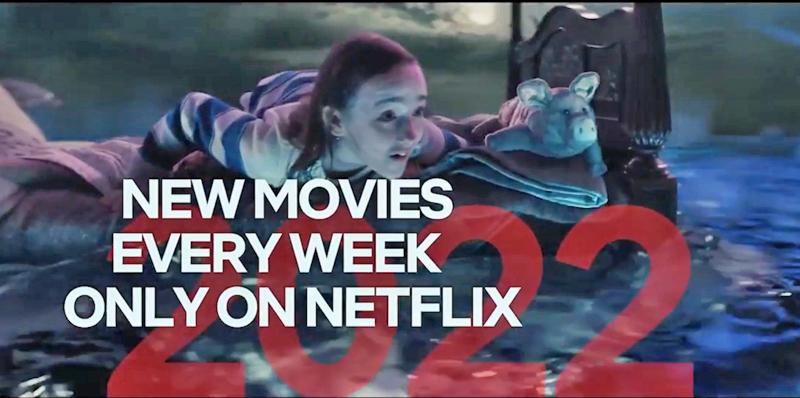
Video streamers and Hollywood personalities took center stage in pricey Super Bowl commercials and eight movie-focused spots were in the mix yesterday.
In an endorsement of the film genre that many pundits overlook, Netflix bought a long 60-second spot simply touting its movie slate dubbed “Movie Preview and the Adam Project” (“Project Adam” is an original supernatural family movie starring Ryan Reynolds). It’s worth highlighting that cinema naysayers claiming streamers just want episodic TV series to spur repetitive viewing are wrong; streamers clearly see their subscribers want movie-like event content in the mix.
It can be argued the eight should be four — since only four were in the game itself: Universal’s sci-fi “Nope,” the Netflix film slate, “Jurassic Park: Dominion”; and Paramount’s “The Lost City.” The other four were in the pregame: Disney’s sci-fi “Doctor Strange in the Multiverse of Madness,” Paramount’s animated family “Sonic the Hedgehog 2,” Sony Pictures adventure “Uncharted” and Universal’s thriller “Ambulance.” The “Jurassic Park” commercial came right as the game started, and is counted here as in-game.
SUPER BOWL MOVIE COMMERCIALS — IN GAME
Universal “Nope” horror-thriller July 22-22
Netflix movie slate/”Adam Project” misc n/a
Universal “Jurassic World: Dominion” sci-fi June 10-22
Paramount “The Lost City” sci-fi March 25-22
The four in-game movie ads are at the low end of the typical range of four-to-eight, though an unusually heavy four more were in the pregame (normally it’s one or two movie ads in the pre-game). Some other reports mentioned Disney’s “Lightyear” and a Warners commercial for four DC Comic movie adaptations as being in the game, but weren’t seen and aren’t counted here (Disney may have substituted a generic Disney+ commercial for the “Lightyear” movie spot).
SUPER BOWL MOVIE COMMERCIALS — PREGAME
Disney “Doctor Strange/Multiverse” sci-fi May 6-22
Paramount “Sonic the Hedgehog 2” kids-animation April 8, 2022
Sony Pictures “Uncharted” adventure n/a
Universal “Ambulance” thriller April 8-22
Beyond pure movie commercials, there were others where film was secondary element. For example, the Super Bowl contained that generic commercial for Disney+ that trumpeted “The greatest movies and shows of all time…get Disney+.” The movie-centric AMC+ (affiliated with the basic cable TV network) is another video streamer with a Super Bowl commercial. Amazon Prime Video presented long commercial for “Lord of the Rings: The Rings of Power” mega-budget TV series, which has a cinematic feel and Disney+ TV series “Marvel Studio’s Moon Knight” is another.
Commercials from video streamers and online media in general are a growing presence in Super Bowl telecasts. And then there’s that aforementioned pure-film Netflix commercial; a week ago, Netflix announced a slate of 86 original movies, which is enough for a premiere film each week (with the legacy Hollywood movie studios hoarding their flicks for their own platforms, Netflix is forced to produce originals to stay relevant in the movie genre). The 86 original Netflix movies promoted in its Super Bowl commercial include “Knives Out 2” and Marilyn Monroe biopic “Blonde.”
Professional football’s championship game, the Super Bowl on NBC Television yesterday is TV’s most expensive media buy at a reported $6.5 million per 30-second commercial in game and attracting a gigantic U.S. audience of around 100 million persons. Commercials in pre-, post and half-time shows are less costly.
That $6.5 million peak price is somewhat exaggerated because NBC Television loaded up commercial slots with in-house/corporate siblings. Comcast is parent of NBC/Universal, video streamer Peacock (multiple Super Bowl spots for its TV series remake “Bel Air”) and Universal Studios theme parks. So NBC/Universal filled the telecast with essentially in-house commercials for its wares, which shrinks the number of slots available to outsiders and thus drives up pricing. Actually, researcher Standard Media Index (SMI) put the average cost of a 30-second Super Bowl commercial this year at $4.8 million, which seems more credible.
Looking beyond filmed content, Hollywood personalities were in so many consumer goods/services commercials it is hard to count. They include Ben Affleck for WynnBet gambling, William Shatner for Planet Fitness health centers, Kevin Hart for Sam’s Club stores, Tommy Lee Jones for Toyota, Gal Gadot for new Covid home-testing device Cue, sports figures (retired footballer Peyton Manning was in multiple blurbs including with his brothers and father for Caesars Sportsbook gambling) and music talent.
A corporate sibling with a tangential spot — appearing in the musical half-time show — is a “Jurassic Park” roller coaster ride at Universal Studios Florida theme park in Orlando (“Jurassic” is based on a book but the NBC/Universal pumps up as a movie-centric franchise).
Cinema-centric movies have long been a major advertising category for the Super Bowl, at four-to-eight commercials per year, out of 60-70 total Super Bowl in-game spots. But with the pandemic shutdown of movie theaters, the most recent “normal” year was 2019. Cinema-going right now is inhibited because of pandemic worries; must-wear-mask requirements are still in place in some locales.
When Super Bowl TV commercials get ranked by entertainment value, movie ads usually place low because they essentially present film clips, which don’t stack up as fresh against lavishly produced spots for consumer goods companies. And in many cases, audiences have seen clips already in movie trailers online.
Related content:
Leave a Reply